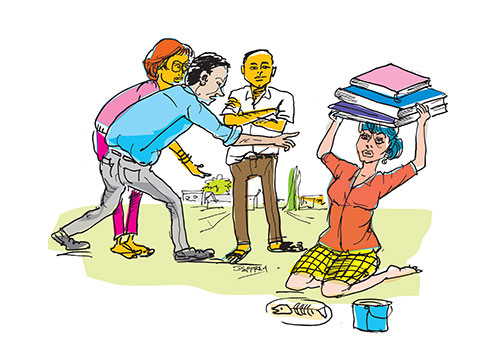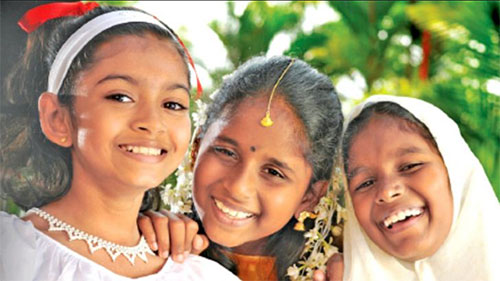by Harshana Rambukwella
Very little in Sri Lanka at the moment inspires hope. We are facing an existential crisis that was inconceivable just six months ago. Sri Lanka is also, ironically, just a year away from marking the 75th year of its independence. As we reflect on these seven decades of postcolonial nation building, and as we confront a future of extreme precarity, our scorecard as a country is not a proud one. Much blood has been spilt in the name of postcolonial nation building and the ethno-nationalist conflict that shaped almost three decades of that history and two youth rebellions against the state speak to a history of division and enmity. While our current predicament cannot be entirely attributed to this conflictual history alone, it surely played more than a small role in shaping our present misery. It is within this context that I want to offer this brief set of reflections on what I feel is an unprecedented form of solidarity that has emerged in Sri Lanka as the aragalaya took shape. While I do not want to romanticize this solidarity because it is a highly contingent phenomenon and is shaped by the extreme nature of the current political and economic conditions, it offers us as a society, but more specifically as educators, something to reflect on as we try to imagine our role in a society that faces a painful process of rebuilding and recovery (though my hope is that such rebuilding and recovery does not mean the repetition of the tired old neo-liberal script we have followed for decades).
Before I explore what I mean by solidarity within the aragalaya, let me briefly reflect on solidarity as a concept. Solidarity is a term sometimes deployed in geopolitics. Particularly in this time of global turmoil where not just Sri Lanka, but many other countries are experiencing serious economic challenges, we see nations expressing solidarity with or towards other nations. However, such solidarity is almost always shaped by instrumental motives. This is what we might call a form of ‘vertical’ solidarity where more powerful and wealthy nations extend a ‘helping hand’ to their more unfortunate counterparts. Therefore, when India says ‘neighbourhood first’ and expresses solidarity with Sri Lanka in this time of trouble one can easily discern this as a hierarchical gesture shaped by instrumental motives. It is in reality, India’s strategic geopolitical interests that largely dominate this narrative of solidarity though one cannot disregard the critical importance of the assistance extended by India and other such ‘powerful’ nations in this time of national distress.
Another form in which solidarity manifests is through what some scholars have termed ‘enchanted’ solidarities. This is literally and metaphorically a distant form of solidarity where intellectuals, activists and others extend solidarity towards a struggle they perceive as deserving their support but without truly understanding the context in which they are intervening. This has often happened with ‘first world’ academics and intellectuals expressing solidarity towards ‘third world’ struggles which they felt were ideologically aligned with their beliefs. One example is how many liberal and leftist intellectuals supported the rise of the Khmer Rouge in Cambodia, believing it to be an anti-imperial liberation movement, only to become disillusioned with the movement as they began to see the full horror of the repression and violence unleashed by the Khmer regime. I think if we reflect on Sri Lanka’s postcolonial history, we can also find many such moments where enchanted solidarities were expressed towards various movements from people in the ‘metropolitan’ center with little understanding of the nuances of the politics on the ground.
Premised against both vertical and enchanted solidarities, scholars have also proposed what is called ‘disenchanted solidarity’. By this they mean a situation where diverse groups, sometimes with very different political and ideological agendas, come together to fight for a common cause. They are often critically conscious of their differences but face a common precarity that pushes them together to struggle and align in ways that were not possible before. Often such moments are also underwritten by anger, though the sources of anger or the objects towards which the anger is directed could be different. I would like to read the aragalaya through this lens of disenchanted solidarity. Particularly at the height of the Galle Face ‘Gota go gama’ protests – before the brutish May 9th attack symbolically ‘killed’ something of the ‘innocence’ of the struggle – there was a sense in which the different groups represented in that space were expressing solidarity towards a singular goal – getting rid of the Rajapakasas and a political system they saw as deeply corrupt – there was anger and a gathering of disenchanted solidarities. For many middle-class people, the aragalaya was a way in which to express their frustration at the lack of the basic necessities of life – be it gas, electricity and fuel – and how a corrupt political class had robbed them of their future. For those with longer histories of political activism such as the IUSF (the Inter University Students Federation) or youth activists from the Frontline Socialist Party or the JVPs youth wing or the many trade unions that supported the aragalaya, this moment in some ways represented the culmination, and perhaps even a vindication, of their longstanding struggles against a political, social and economic order that they consider fundamentally unfair and exploitative. Of course, within this larger narrative, there were and continue to be pragmatic political calculations, particularly from groups affiliated with political parties. At the same time, we also witnessed ethnic and religious minorities, often historically marginalized in Sri Lanka’s social and political mainstream finding a rare space to express their anger at the ways in which they have been discriminated against. However, the argalaya gave them a rare space to do so by channeling their anger as a form of solidarity towards the common goal of getting rid of the Rajapaksa dynasty and the corrupt political system as a whole.
But at the same time, we also saw the tenuous nature of these disenchanted solidarities in the aftermath of the 9th May attack on ‘Gota go gama’. Initially we saw another spectacular display of organic and spontaneous solidarity when health workers and office workers abandoned their workstations and rushed to ‘Gota go gama’ when news of the attack broke. But by the evening of that day the story had turned more insidious with a wave of attacks against the properties of politicians and others thought to have been involved in the attack against the peaceful aragayala participants. While we may understand and even empathize with this backlash, its violent nature and what appeared to be other instrumental motives driving it, such as the looting and revenge attacks, made it difficult to associate it with the moral principles that had animated the aragalaya thus far.
Thereafter, at the current moment I am writing, the aragalaya also appears to have lost some of its vital energy as the political configuration has shifted and the tragi-comedy of Sri Lanka’s realpolitik with its underhand deals and political mechanizations seems to have regained the upper hand.
However, what does this mean? Does it mean post May 9th the aragalaya has lost its meaning and purpose or can we push our analysis a little deeper. At this point I would like to introduce one final way in which scholars have discussed solidarity which I feel is appropriate to understand the aragalaya and the spirit that underwrote it and continues to underwrite it. This is what some scholars have called ‘deep solidarity’ – a situation where in today’s neo-liberal context where the vast majority of the population come to a realization of their common social and economic predicament and realize their common enemy is the symbolic ‘one percent’ or an insidious nexus between crony capital and political power that disempowers them. This is of course an idealistic conception but one which I feel holds true at least partially to this moment in Sri Lanka. People from widely varying social and economic strata, from different religious persuasions and people with wildly different ideological and political beliefs have been suddenly pushed together. They are all standing in the never-ending petrol and diesel queues, they are desperately hunting for the next cylinder of gas and increasingly many of them are going hungry. The privileges and the divisions that once defined them, no longer seem to be so ‘real’ and the one stark reality confronting them is a form of existential annihilation. I believe within the aragalaya we can glimpse traces of this deep solidarity and as an educationist I think it is our vital task to think of creative ways in which we might sustain this solidarity, grow it and nurture it, so that we can at least ‘imagine’ a better future. These are idealistic sentiments, but at least for me, such hope, is a political and pedagogical necessity of the current moment.



